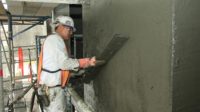Stucco has been installed for centuries as an exterior coating on buildings both commercial and residential. It’s been smeared over straw, spread over brick, installed over wood and steel studs and has been criticized and applauded because everyone has an opinion, and judging the beauty or lack of beauty when looking at a wall is completely subjective.
There are concrete ways to judge a stucco project.
The first comment about judging plaster is how far away from the wall or building do you stand to judge the work? Common sense would indicate that you don’t judge the wall with your nose 2 inches from the finish. The average distance is about 9 feet away but when looking at higher elevations, a good set of field glasses help. The other common sense pre-inspection comment is to judge plaster in ambient light. That means you cannot or should not make judgments about a finished stucco coat in critical light situations that last for less than an hour. The last comment is that the plaster should be pleasing to the eye.
Following ASTM C-926 Section 7.1.2: The plaster should be applied according to the nominal thickness (specified in Table 1). We also understand that plaster bases to receive Portland cement plaster should be straight and true within 1/4 inch in 10 feet. Visually, this means that any eye-catching out of plane areas should not occur. Any significant gouges or mounds should have been straightened in the brown coat and if it is enough to catch your eye in the finish coat should be repaired.
ASTM C-926 Section 7.2.3 suggests that the finish coat shall be applied with sufficient material and pressure to ensure tight contact with, and complete coverage of the base coat. This means no holidays, no shiners, no hollows, and no delamination of the finish. This means an even finish coat and/or texture coat tightly bonded.
Section 12. Environmental Conditions suggest strongly that plaster not be applied to frozen base or have frozen ingredients and should be protected from freezing. Frozen finish has ice like impressions and is soft. Frozen basecoats cannot be hardened by curing.
Section 12.2 speaks to uneven or excessive evaporation during dry weather and from strong blasts of dry air. Basecoats, if exposed to these conditions can be cured with additional moisture. Finish coats and basecoats if judged soft can be successfully hardened with concrete curing compounds.
A.2 of the same standard has a plethora of issues from which to determine whether the stucco installation is worthy. Sufficient slope of plastered surfaces is very important.
A2.1.3 talks about ensuring that there are no exposed edges of plaster open to moisture intrusion. So caulk when necessary. Equally important is not caulking when not necessary.
The Appendix of ASTM C-926 X1.1.4.1 indicates that some slight variations in the color of the finish are a part of the process due to a variety of factors. Judging those variations as slight, minor, fairly significant and significant gives you a range from which to choose what has occurred with the finish color. Major differences in shade are never acceptable.
Anyone who is tasked with judging stucco finishes needs to determine prior to the inspection whether the finish is going to be painted or coated. Judging fine tight cracking or map cracking in a finish coat and having the owner demand that the crack gets fixed prior to paint becomes an unwinnable process if you are blind-sided by a lack of information.
In X1.2 Finish Coat Categories, the language speaks to the condition of the base to which the texture is applied. It is part of the judgment process to determine whether the base has been properly prepared for the type of finish texture specified. A fine dash coat might need the brown coat floated with a green float to bring out the sand, pre-finished with a sand float finish to fill voids and scraped to knock down clinkers. Sand finished walls might need to be scratched and doubled back to ensure an even finish is achieved if the base is pockmarked with voids.
X1.3.1: If finish is stained from moisture trapped in the plaster, determining the source of the moisture and abatement of the moisture intrusion is a good call before re-coating the finish, which could be necessary. Wash coats installed with Hudson sprayers can help mitigate staining, and in some instances if installed immediately after finish coat application can ensure a successful installation.
Judging Trim and Accessories
Part of the process of judging stucco projects demands determining whether the trim and accessories are installed according to the minimums contained in ASTM C-1861.
7.11 Application of Accessories contains standards for levels of flat, plumb, and straight. Ensuring that field joints are in plane, that the use of 10’ pieces whenever possible has occurred also determine top quality jobs.
Corners whether squared or mitered should be clean and tight in base screeds, casing beads or control joints. Panel sizes should reflect the language in ASTM C-1063 7.11.4.1, .2, and .3 and defining panels that are not within length to width ratios can indicate potential crack situations.
Make sure that the decorative metal trim pattern is consistent, straight, flat and true. Part of the process of judging plaster projects with metal trim is whether the trim is pleasing to the eye.
Being able to judge plaster fairly and with consistency will ensure higher installation standards and higher quality finished projects.











Report Abusive Comment